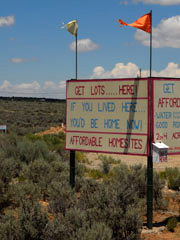At the heart of this issue are the dynamics of speculation. Eschewing traditional measures of fundamental value and
focusing instead on the adaptability of price movements, the speculator enters into a pact with time, value, and uncertainty
(disparity of knowledge). But what land speculators of early and mid 20th century America relied on, in addition, was a structural misfit between
distance and proximity that was a hallmark of the geographical imaginary of America. In a territory that exists beyond the prevailing models of
land use economics--from Ricardo's Law of Rent through von Thunen's Land equations, forward to the Chicago School's sociological maps--20th century
land speculation requires an updated economic theory of the margin. That is, it requires a model where distance and transport costs factor as
additive--rather than subtractive--variables in a calculus of speculative advantage. Here, the swamps of Florida and the desert of New Mexico are
precisely those tracts with the coveted traits of isolation, remoteness, and inaccessibility. |
